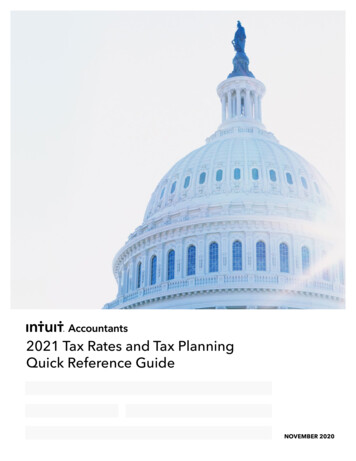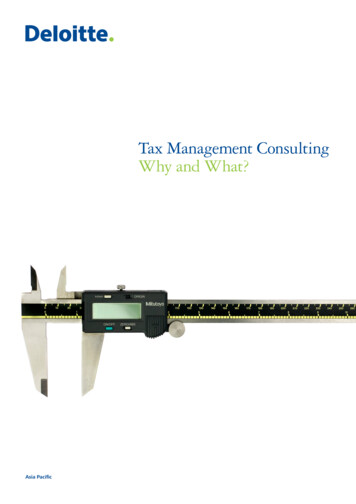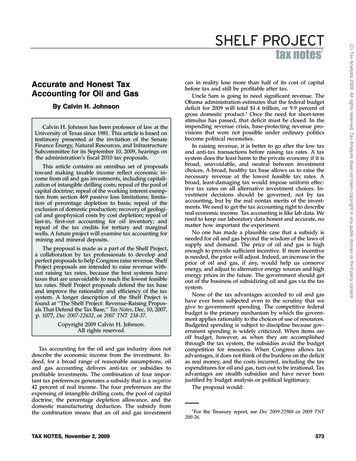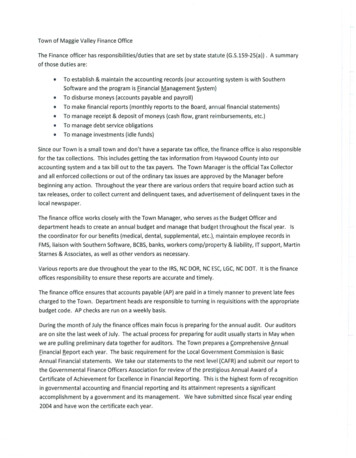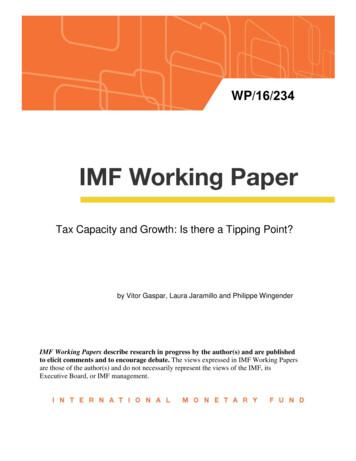
Transcription
WP/16/234Tax Capacity and Growth: Is there a Tipping Point?by Vitor Gaspar, Laura Jaramillo and Philippe WingenderIMF Working Papers describe research in progress by the author(s) and are publishedto elicit comments and to encourage debate. The views expressed in IMF Working Papersare those of the author(s) and do not necessarily represent the views of the IMF, itsExecutive Board, or IMF management.
2 2016 International Monetary FundWP/16/234IMF Working PaperFiscal Affairs DepartmentTax Capacity and Growth: Is there a Tipping Point?Prepared by Vitor Gaspar, Laura Jaramillo and Philippe Wingender1Authorized for distribution by Vitor GasparNovember 2016IMF Working Papers describe research in progress by the author(s) and are published to elicitcomments and to encourage debate. The views expressed in IMF Working Papers are those of theauthor(s) and do not necessarily represent the views of the IMF, its Executive Board, or IMFmanagement.AbstractIs there a minimum tax to GDP ratio associated with a significant acceleration in theprocess of growth and development? We give an empirical answer to this question byinvestigating the existence of a tipping point in tax-to-GDP levels. We use two separatedatabases: a novel contemporary database covering 139 countries from 1965 to 2011 anda historical database for 30 advanced economies from 1800 to 1980. We find that theanswer to the question is yes. Estimated tipping points are similar at about 12¾ percent ofGDP. For the contemporary dataset we find that a country just above the threshold willhave GDP per capita 7.5 percent larger, after 10 years. The effect is tightly estimated andeconomically large.JEL Classification Numbers: H11, H26, O10, O43Keywords: income per capita, taxation, development, multiple equilibriaAuthors’ e-mail addresses: vgaspar@imf.org, ljaramillomayor@imf.org, pwingender@imf.orgWe are grateful to David Lipton for inspiring the research question. We thank Sanjeev Gupta, Mick Keen, AbdelSenhadji, Bernardin Akitoby, Rossen Rozenov, Andrew Hodge, Marialuz Moreno Badia, Xavier Debrun, VikramHaksar, Albert Touna Mama and Aart Kraay for helpful comments and discussion. We are also grateful toparticipants of the IMF Fiscal Affairs Department seminar for their useful suggestions. We thank Elijah Kimani forexcellent research assistance.1
3Abstract 2I. Introduction 5II. Taxation and economic development 6A. How is taxation linked to greater economic development? 6B. Tipping points: how can a small change in taxes lead to large changes in GDP? 9C. Stylized Facts 10III. Data 12IV. Empirical approach 15A. Methodology 15B. Results based on the contemporary database 18C. Results based on the historical database 25V. Conclusion 29References 31Figures1. Complementarities in State Capacity 82. Tax Capacity, Social Norms, and Accountability 93. Tax to GDP and Income Levels 114. Tax Capacity and Legal Capacity, 2012 115. Tax Capacity and Public Administration Capacity, 2012 126. Contemporary Database: Number of Observations for Tax to GDP 137. Contemporary Database: Distribution of Average Annual Real GDP per Capita Growthand Tax to GDP Ratios 148. Historical Database: Number of Observations for Tax-to-GDP 149. Historical Database: Distribution of Average Annual Real GDP per Capita Growth andTax to GDP 1510. Searching for a Tax Tipping Point at Different Horizons 1911. Impact of the Tax Threshold on 10-year Cumulative Growth 2112. Impact of the Tax Threshold over Time 2313. Searching for a Tax Tipping Point at Different Horizons, Historical Database 2614. Impact of the Tax Threshold on 10-year Cumulative Growth, Historical Database 2715. Impact of the Revenue Threshold over Time, Historical Database 28Tables1. Sources for Tax-to-GDP data 132. Testing for Statistical Significance of Tax Thresholds 203. Estimated Tax-to-GDP Thresholds 204. Estimating Growth Effects 245. Estimating Tax Revenue-to-GDP Thresholds, Historical Database 27
46. Estimating Growth Effects, Historical Database 29Appendix 35Appendix figureA1. Impact of a Tax Threshold on 3-year Cumulative Growth 35A2. Impact of a Tax Threshold on 5-year Cumulative Growth 35A3. Impact of a Tax Threshold on 7-year Cumulative Growth 36Appendix tablesA1. Tipping Point Crossing, Contemporary Database 37A2. Summary Statistics, Historical Database 39A3. Tipping Point Crossing, Historical Database 40
5I. INTRODUCTIONIs there a minimum tax-to-GDP ratio associated with a significant acceleration in theprocess of growth and development? This paper proposes a new way to quantify the relationbetween taxes and growth by investigating the existence of a tipping point in tax-to-GDP levels.Tipping points can occur in environments characterized by multiple equilibria and are associatedwith sharp changes occurring around some threshold.We use a novel contemporary database covering 139 countries and spanning the period1965-2011. We combine the approaches taken by Card, Mas and Rothstein (2008) usingregression discontinuity design methods with the threshold regression framework proposed byHansen (1999) to provide new estimates of tax tipping points.Our approach provides new empirical estimates that build on earlier work by Besley andPersson (2011, 2013, 2014a, 2014b). We go beyond the existing literature in two dimensions:(i) we rely on a much broader database, both in coverage of countries and years; and (ii) we use anon-linear model to flexibly estimate the reduced-form relation between tax levels andsubsequent GDP growth. Specifically, we use a regression discontinuity design model to estimatea growth tipping point.Our focus is on tax revenues as other sources of revenue have not been found to be closelyrelated to economic development. Arezki et al. (2011) and IMF (2015) illustrate that countriesthat have an abundance of natural resources often show a record of relatively poor economicperformance compared with non-resource-rich countries. In the case of foreign aid, there is noconsensus on its effects on economic development. Some argue that official assistance hasharmed poor countries throughout the years, while others believe that aid levels have been toolow. Edwards (2014) provides a useful overview.From a conceptual viewpoint we follow the path openned by Joseph Schumpeter in hisfamous paper The Crisis of the Tax State (Schumpeter, 1918). Schumpeter links state and taxso closely that he stresses that his expression “tax state” can be regarded as almost pleonastic.He emphasizes that taxes are not only associated with the historical origin of the state, they arealso active in shaping it. In his view the organic development of taxation was associated with theorganic development of other dimensions of the state. It is particularly important for ourpurposes to stress Schumpeter’s distinction between taxes and other forms of governmentrevenue. From the viewpoint of the Tax State, the dependence on revenues from patrimony orentrepreneurial activity is characteristic of an earlier stage of Public Finance development. ForSchumpeter, the analysis of the consequences of taxation requires a long run perspective thatallows for structural and self-reinforcing evolutionary dynamics to play out in full. Thesedynamics are not only economic but also social and political. We interpret Besley and Persson asbringing a similar perspective to contemporary research. We would like to place our contributionwithin this tradition.
6The answer to the question with which we begin the paper is made difficult by the jointdetermination of GDP and the tax-to-GDP ratio. We want to investigate how tax-to-GDP isassociated with subsequent growth. But it is also the case that GDP growth is associated withincreases in the tax-to-GDP ratio. This may be rationalized, for example, in terms of the so-calledWagner’s Law. In the process of economic development, the demand for public servicesincreases faster than GDP, leading to an increased in government’s expenditure-to-GDP ratio.Since these tend to be financed, at the margin, by taxation, a similar increase in the tax-to-GDPratio ensues. We mitigate the issue by focusing on local effects, i.e. how small changes in taxesaround a specific tipping point lead to potentially large change in subsequent growth, asopposed to estimating global relations such linear models. We also find that our local results arerobust when controlling for the potential endogeneity of taxes.2The paper is organized as follows. Section II provides a short selective review on the relevantliterature on the relationship between taxation and economic development. It also discusses theintuition on how a small change in taxes can lead to large changes in GDP. Section III describeshow we compiled our two databases—the contemporary database and the historical database.Section IV explains the methodology used and the empirical results obtained. Section Vconcludes.II. TAXATION AND ECONOMIC DEVELOPMENTA. How is taxation linked to greater economic development?When studying the relationship between taxation and economic development, there is astrand of literature that focuses on how development influences the evolution of the taxsystem. The emphasis is on the economic constraints that influence the government’s ability toimpose a particular tax rate on a particular tax base. For example, Tanzi (1992) and Burgess andStern (1993) find that countries with a higher share of agriculture and a lower share of importsto-GDP tend to have lower taxation. Gordon and Li (2009) emphasize the link between taxationand formal finance. They argue that firms have incentives to evade taxes by conducting allbusiness in cash in countries where the value from using the financial sector is more modest. Inthe same vein, Kleven, Kreiner, and Saez (2009) show that in more developed countries, firm sizeis sufficiently large to make third-party tax enforcement effective, as income witholding facilitatescross-checking of tax records between indviduals and firms. Others have argued that largeinformal sectors in poor economies are inherently hard to tax, as discussed in the survey by Joshiet al. (2014). La Porta and Shleifer (2014) discuss the desire to avoid taxes as an important motivefor informality.Access to forms of revenue other than taxes has also been associated with lower taxation.Jensen (2011) finds that a 1 percent increase in the share of natural resource rents in totalgovernment income is associated with a 1.4 percent lower share of taxation in GDP. Benedek etal. (2014) find a negative association between foreign aid and domestic tax revenues, particularlyin low-income countries and in countries with relatively weak institutions.2We use the IV threshold model proposed by Caner and Hansen (2004). Results are available upon request.
7Of course, there is another strand of literature that studies the influence of the tax systemon the economy. Barro (1990) discusses how the economy can be made more productive whentax revenues are spent on public goods and investments. Barro and Sala-i-Martin (1992) showthat, in endogenous-growth models, well-designed tax systems can minimize the efficiencylosses imposed by taxes and can even raise the GDP growth rate. For sub-Saharan Africa, Ebekeand Ehrhart (2011) find that the instability of tax revenue leads to the instability in publicinvestment and government consumption, and it also reduces the level of public investment.Seidel and Thum (2015) argue that stricter tax enforcement forces corrupt officials to reducebribe demands, which makes market entry by private firms more attractive.Several authors have augmented the standard approach, giving political and institutionalfactors a key role in the analysis of taxation and development. Most notably, Besley andPersson (2011, 2013, 2014a, 2014b) emphasize the broader concept of state capacity to stand fora range of capabilities that are needed for the state to function effectively. State capacityincorporates investment by the government in building three key dimensions: (i) fiscal capacity,by increasing collection of taxes, especially broad-based taxes, through stronger taxenforcement; (ii) legal capacity, which refers to market-supporting regulation, enforcement ofcontracts, and protection of property rights; and (iii) collective capacity by augmenting markets,mostly by supplying public goods. Besley and Persson (2011) also suggest that manydeterminants of state capacity are common across these dimensions. They carry out simpleregression analyses for a cross-section of 111 countries to show the correlation betweencommon factors (war, ethnic homogeneity, political stability, constraints on the executive) andmeasures of fiscal and legal capacity.Building on Besley and Persson, Figure 1 illustrates the link between taxation and greatereconomic development. State capacity is shaped by the interaction between tax capacity, legalcapacity, and public administration capacity. Tax capacity not only provides a stable and elasticsource of revenue for the government to finance its activities, but a government with a largerstake in the economy through a developed tax system also has stronger motives to play aproductive role in the economy. Public administration capacity refers to the government’seffective and efficient use of public money.3 This directly impacts the ability of governments toimplement policy and deliver public services, which in turn influences citizens’ trust ingovernment. Legal capacity refers to the government’s ability to secure private property rights.This includes legal infrastructure such as building the court system and registering property.It is important to note that tax capacity, legal capacity, and public administration capacityare complements. Sustained improvements in tax collection do not occur in a vacuum. Buildingtax capacity requires investment in legal capacity, and vice versa. This is why we would expecttax, legal, and public administration capacity to be positively correlated with one another. Thesefeedback loops can also give rise to multiple equilibria as noted for example in Besley andPersson (2013).For example, Pritchett (2000a) and IMF (2015) discuss how weaknesses in public investment management haveresulted in inadequate returns to public investment in many countries.3
8The strength of tax capacity depends crucially on social norms of compliance. Kiser andLevi (2015) emphasize that the more a government is effective and trustworthy, the morelegitimacy it is likely to attain, and the more it will be able to elicit compliance without excessivemonitoring or punitive action. Similarly, as proposed by Levi (1988), the government can achievea high degree of quasi-voluntary compliance with the taxation system when citizens comply withtaxation out of a combination of strategic and normative considerations. Strategic considerationsrefer to the calculation of the probability of being caught and the punishment involved.Normative considerations refer to a sense of fairness: the citizen believes that sufficient publicgoods are being provided in return for tax payments, and that others are also paying their fairshare. A variety of other authors have also argued that creating a culture of compliance is centralto raising revenue. For example, Gordon (1989) refers to individual morality, Posner (2000) to taxcompliance norms, and Torgler (2007) to tax morale. Social norms of compliance are in turnclosely associated with a higher demand by citizens for accountable and transparentgovernment, as argued by Moore (2007), Brautigam et al. (2008) and Ross (2004). Theserelationships are illustrated in Figure 2.Figure 1. Complementarities in State CapacityFinally, our paper can also be linked to the recent literature on growth accelerations (seefor example Hausman et al. 2005, Pritchett 2000b and Berg et al. 2012). While the averageeffect on growth of crossing the tax-to-GDP tipping point isn't quite as high as the highestgrowth acceleration episodes considered in several of these studies4, we find that average annualgrowth rates are higher by about 0.75 ppa over 10 years compared to countries that remainbelow the tipping point. This qualifies as an important and large driver of sustained growthFor example, Hausman et al. (2005) consider episode where GDP per capita growth rates increase by 2.5 ppasustained over 8 years.4
9episodes in addition to several other variables that have been consistently associated with theseepisodes such as investment and trade, political regime changes and economic reform andequality of the income distribution (Hausman et al. 2005, Berg et al. 2012).Figure 2. Tax Capacity, Social Norms, and AccountabilityB. Tipping points: how can a small change in taxes lead to large changes in GDP?As shown by Card et al. (2008), multiple equilibria can arise in settings where feedbackloops occur among agents—when individual preferences depend on choices made by otheragents. Importantly, the authors show how multiple equilibria can be identified in the data byestimating tipping points, i.e. cases where small changes in initial conditions give rise to largechanges in outcomes.5 Specifically, one can identify tipping points whenever the economy‘jumps’ from one equilibrium to another. If taxpayers and policy makers’ decisions werecharacterized by such strategic complementarities, it could in principle be possible to find caseswhere small changes in taxes lead to large changes in growth.A shift in social norms can push a country out of a low tax compliance equilibrium into ahigh tax compliance equilibrium as discussed, for example, by Traxler (2010). Suchenhanced tax capacity could then lead to a virtuous cycle in behavior and institutions that willhave a positive impact on growth. The virtuous cycle could be triggered through severalchannels. Greater tax compliance enlarges the tax base, which can reduce the marginal cost ofpublic funds. In turn, this enables greater spending by the government on state capacitybuilding. An increase in cooperative behavior and trust can also make it easier to realize5A recent example applied to taxpayers’ behavior is proposed by Traxler (2010).
10agglomeration effects in production as more individuals and firms participate in formal markets.Furthermore, greater accountability from a larger pool of taxpayers can improve governance andhelp decrease corruption, further reducing barriers to market entry by firms and supportingeconomic growth (Murphy, Schleifer, and Vishny, 1993).We argue that as countries approach and eventually exceed some revenue threshold,growth outcomes for these countries would then jump discontinuously. Card et al. (2008)demonstrate that tipping points can be identified and estimated through the use of regressiondiscontinuity design (RDD) methods. We apply the approach to the relation between tax-to-GDPlevels and subsequent GDP growth. In particular, we look for levels of tax-to-GDP around whichwe observe sharp changes in subsequent GDP growth rates. We interpret our findings assuggestive of the possible presence of multiple equilibria in tax compliance and capacity: smallvariations in tax levels around a tipping point can lead to economies jumping from oneequilibrium to another. This in turn can lead to large differences in growth as some countriesreach the high compliance/high growth equilibrium while others remain in the lowcompliance/low growth equilibrium.C. Stylized FactsStylized facts illustrate the relationship between tax capacity and economic development.Figure 3 shows the positive relationship between tax-to-GDP and real GDP per capita, using twoseparate samples of countries. Using a cross-section of data for 2012, the figure shows thathigher income countries tend to raise more tax revenue as a share of GDP than lower incomecountries. Using historical time-series data going back to the 1800s for 30 countries, the figureshows a similar trend, where tax-to-GDP rise over time along with income levels. These findingsare in line with the reading of Wagner’s Law that we suggested earlier.Figure 4 illustrates the complementarity between tax capacity and legal capacity. The figureshows that countries with higher tax revenue-to-GDP also tend to have stronger protection ofproperty rights, as measured by a Fraser Institute indicator of legal structure and property rights.The figure also shows that higher tax-to-GDP is associated with higher quality of governmentpolicies and regulation, as measured by the Worldwide Governance Indicators.Figure 5 illustrates the complementarity between tax capacity and public administrationcapacity. The figure shows a negative relationship between tax-to-GDP and a corruption indexby Transparency International. This suggests that tax capacity is once again associated withgreater government transparency and accountability. The figure also shows that countries withhigher tax-to-GDP also tend to have stronger budget institutions, as measured by the PublicInvestment Management Efficiency (PIE-X) index.
11Figure 3. Tax to GDP and Income LevelsSources: International Historical Statistics, World Economic Outlook, and authors’ estimatesFigure 4. Tax Capacity and Legal Capacity, 2012Sources: Fraser Institute, Worldwide Governance Indicators, World Economic Outlook.Note: The Fraser Institute indicator for legal structure and property rights is the average across indicators ofjudicial independence, impartial courts, protection of property rights, military interference in the rule of law andpolitics, integrity of the legal system, legal enforcement of contracts, regulatory restrictions on the sale ofproperty, reliability of police, and business costs of crime. The Worldwide Governance Indicator of regulatoryquality reflects perceptions of the ability of the government to formulate and implement sound policies andregulations that permit and promote private sector development.
12Figure 5. Tax Capacity and Public Administration Capacity, 2012Sources: Transparency International, Fiscal Affairs Department, World Economic OutlookNote: Public Investment Management Efficiency (PIE-X) is an IMF tool that measures the relationship between theaccumulated public capital stock per capita and various indicators of the quality of and access to infrastructure.The closer a country is to the efficiency frontier, the more efficient its public investment.III. DATAWe rely on two independent databases for our analysis: a contemporary database and ahistorical database.The contemporary database assembles a large unbalanced panel consisting of tax-to-GDPand real GDP per capita for 139 countries from 1965 to 2011. Data on tax-to-GDP ratios arecollected from several sources. We combine, in order and when available, data on general orcentral government tax-to-GDP ratios from the following sources: (1) OECD; (2) Mansour (2014,2015) for sub-Saharan African and MENA countries; (3) World Economic Outlook; (4) GFSM 1986Historical Government Finance Statistics; and (5) the International Centre for Tax andDevelopment’s Government Revenue Dataset. Splicing is used to combine the different sources.Table 1 indicates the time period and number of countries available for each individual source.6The IMF’s World Revenue Longitudinal Data set (WoRLD) offers a similar compilation of government revenueswith more detailed information by type of revenue starting in 1990. Our results are identical when using WoRLDdata (available at http://data.imf.org/revenues).6
13Table 1. Sources for Tax-to-GDP dataDatabaseTax-to-GDP (all sources)1- OECD2- Mansour (2014, 2015)3- World Economic Outlook4- GFSM 1986 Historical Government Finance Statistics4- The International Centre for Tax and 01113947381985-20111970-20021980-2010777040To study growth across countries and over time, we use real GDP per capita at constantnational prices, obtained the Penn World Tables 8.1 (Feenstra, Inklaar and Timmer, 2015).7Figure 6 shows the number of observations on tax-to-GDP available by year for advanced anddeveloping countries. Figure 7 shows the distribution of tax-to-GDP and average annual real percapita GDP growth rates across the contemporary database.The historical database is also an unbalanced panel consisting of tax-to-GDP ratios andreal GDP per capita for 30 advanced countries between 1800 and 1980.8 Data on tax-to-GDPis from the International Historical Statistics (Mitchell, 2003). Data on real GDP per capita (inGK 1990) is from the Maddison Project 2013 version. Figure 8 shows the number ofobservations on tax-to-GDP by year. Figure 9 shows the distribution of tax-to-GDP and averageannual real per capita GDP growth rates across the historical database.Figure 6. Contemporary Database: Number of Observations for Tax to GDP150EmergingAdvanced1005001965 1970 1975 1980 1985 1990Year1995 2000 2005 2010We drop from our sample countries where natural resource rents, as measured in the World DevelopmentIndicators, exceeds 30 percent on average over the entire sample.7Countries are: Australia, Austria, Belgium, Canada, Chile, Czech Republic, Denmark, Estonia, Finland, France,Germany, Greece, Hungary, Israel, Italy, Japan, Korea, Mexico, Netherlands, New Zealand, Norway, Poland,Portugal, Slovenia, Ireland, Spain, Sweden, Switzerland, United Kingdom, United States.8
14Figure 7. Contemporary Database: Distribution of Average Annual Real GDP per CapitaGrowth and Tax-to-GDP RatiosDistribution of Average Annual Real GDP perCapita Growth Rate for Each Country, 19652011 (percent)Distribution of Tax-to-GDP Ratios,1965-2014 (percent)300Number of country/yearsNumber of countries252015105Median: 1.9%Median: 16.9%20010000-202468Average real GDP per capita growth rate0204060Average real GDP per capita growth rateSources: Penn World Tables 8.1; OECD; Mansour (2014, 2015); World Economic Outlook; GFSM 1986; and theInternational Centre for Tax and Development’s Government Revenue Dataset.Note: Average annual real GDP per capita growth rate for each country is calculated with formula used by theBureau of Economic Analysis (BEA), which is a variant of the compound interest formula (seehttp://www.bea.gov/faq/index.cfm?faq id 463). Initial year is 1965 or earliest available for each country.Figure 8. Historical Database: Number of Observations for Tax-to-GDP252015105018001820184018601880 1900Year1920194019601980
15Figure 9. Historical Database: Distribution of Average Annual Real GDP per Capita Growthand Tax-to-GDPDistribution of Average Annual Real GDP perCapita Growth Rate for Each Country, 18201980 (percent)6Distribution of Tax-to-GDP Ratios,1800-1980 (percent)20042Number of country/yearsNumber of countriesMedian: 1.6%Median: 11.7%150100500011.21.41.61.82Average real GDP per capita growth rate0204060Average real GDP per capita growth rateNote: Average annual real GDP growth rate for each country is calculated with formula used by the Bureau ofEconomic Analysis (BEA), which is a variant of the compound interest formula (seehttp://www.bea.gov/faq/index.cfm?faq id 463). Initial year is 1800 or earliest available for each country.IV. EMPIRICAL APPROACHA. MethodologyAs in Card, Mas and Rothstein (2008) (CMR hereafter), we use a regression discontinuitydesign (RDD) to investigate the existence of a tipping point in tax-to-GDP ratios on GDPgrowth. Our approach entails estimating and testing both for the existence of an unknownthreshold as well as measuring the impact of crossing this threshold on subsequent GDP growthfor the average country in our sample.Specifically, we model cumulative GDP per capita growth rate 𝐺𝐷𝑃𝑃𝐶𝑐𝑡 𝑗 in country 𝑐, year 𝑡over some horizon 𝑗 as some function of the tax-to-GDP level
between taxes and growth by investigating the existence of a tipping point in tax-to-GDP levels. Tipping points can occur in environments characterized by multiple equilibria and are associated with sharp changes occurring around some threshold. We use a novel contemporary database covering 139 countries and spanning the period 1965-2011.


